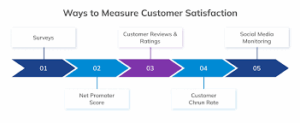Customer satisfaction is more important than ever in today competitive market place. Companies that exceed customer expectations don’t just keep loyal customers; they also attract new ones through word- of-mouth recommendation. Customer satisfaction scores (CSAT) are a way for businesses to measure whether they are meeting the expectations of their customers and teams. But how do you effectively raise these scores?
This article explores proven strategies to improve customer satisfaction scores, backed by research, real-world examples, and the latest trends such as AI, data analytics, and automation. By the end, you’ll have actionable insights to transform your customer experience and achieve sustainable success.

Understanding Customer Satisfaction Scores (CSAT)
What is Customer Satisfaction Score?
Customer Satisfaction Score (CSAT) is a key performance indicator (KPI) used by businesses to measure how satisfied customers are with a product, service, or overall experience. Typically gathered through surveys, CSAT is often expressed as a percentage or average score based on customer feedback.
Why CSAT Matters
High CSAT scores indicate that customers’ expectations are met or exceeded, leading to:
- Increased customer loyalty
- Higher retention rates
- More referrals and positive reviews
- Competitive differentiation
Conversely, low scores signal dissatisfaction, which can result in lost revenue and damage to brand reputation.
Proven Strategies to Boost Customer Satisfaction Scores
1. Deliver Exceptional Customer Service
Exceptional service is the cornerstone of high satisfaction. Train your staff to be empathetic, knowledgeable, and responsive. Customers value interactions where their problems are understood and resolved quickly.
Key actions:
- Implement comprehensive employee training programs
- Empower staff with decision-making authority
- Use customer feedback to identify and close service gaps
2. Leverage Data Analytics for Personalized Experiences
Data analytics allows you to understand customer behavior, preferences, and pain points deeply. By analyzing purchase history, browsing patterns, and feedback, businesses can tailor their offerings and communication.
Benefits:
- Personalized product recommendations
- Customized promotions and offers
- Proactive issue resolution
3. Utilize AI and Automation to Enhance Support
AI-powered chatbots, automated ticketing systems, and virtual assistants improve response times and availability. Automation handles repetitive tasks efficiently, allowing human agents to focus on complex issues.
Impact on CSAT:
- 24/7 customer support
- Faster resolution times
- Reduced operational costs
4. Collect and Act on Customer Feedback Regularly
Consistent feedback collection helps identify dissatisfaction sources early. Use surveys, social media monitoring, and reviews to gather insights, then demonstrate you are acting on them.
Best practices:
- Keep surveys short and relevant
- Ask open-ended questions for detailed input
- Close the feedback loop by communicating changes made
5. Improve Product and Service Quality
A high-quality product or service naturally drives satisfaction. Regularly review product performance, invest in R\&D, and respond to quality-related complaints swiftly.
6. Simplify the Customer Journey
Complicated processes frustrate customers and lower satisfaction. Map out your customer journey to identify friction points and streamline interactions, whether online or offline.
Areas to optimize:
- Website usability
- Checkout process
- Customer onboarding
7. Build Trust Through Transparency and Communication
Transparent policies, clear communication, and honest marketing build trust. Customers appreciate knowing exactly what to expect, leading to higher satisfaction.
The Role of AI, Data Analytics, and Automation in the Future of Customer Satisfaction
The integration of AI, data analytics, and automation is revolutionizing how businesses manage customer satisfaction:
- AI enables predictive analytics to anticipate customer needs before they arise. For example, AI can detect dissatisfaction signals and trigger personalized outreach.
- Data Analytics provides a 360-degree view of the customer, enabling deeper segmentation and more effective targeting.
- Automation ensures quick, consistent service across multiple channels without human error or delay.
Together, these technologies empower businesses to create seamless, personalized, and proactive customer experiences that significantly boost CSAT scores.
Measuring Success: Tools and Metrics to Track
To ensure your strategies are effective, regularly monitor these metrics:
- Customer Satisfaction Score (CSAT): Direct measure of satisfaction after interaction or purchase.
- Net Promoter Score (NPS): Measures likelihood to recommend.
- Customer Effort Score (CES): Indicates ease of experience.
- Churn Rate: Reflects customer retention.
- Average Resolution Time: Measures support efficiency.
Use dashboards and real-time analytics to track trends and make data-driven decisions.
Customer satisfaction scores can be elevated only if you dedicate yourself to providing excellent service, use modern technology, and yearn for eternally-enhancing results. Offering personal, human-centred brands, having AI and automation integrated, being open, companies of any size can build fan/customer base which today’s market demands.
The future of sales and customer success is the intelligent application of AI, data analysis, and automation redefining the way companies perceive and reach out to their customers. Applying these proven strategies positions your business for lasting success, higher CSAT scores, and stronger competitive advantage.
FAQ: How to Boost Customer Satisfaction Scores
Q1: What is the fastest way to improve customer satisfaction scores? A1: Focus on enhancing customer service quality by training staff and responding quickly to issues, combined with gathering actionable feedback.
Q2: How does AI improve customer satisfaction? A2: AI offers 24/7 support through chatbots, predictive analytics for proactive service, and automation of routine tasks, resulting in faster, more personalized interactions.
Q3: How often should businesses collect customer feedback? A3: Ideally, collect feedback continuously through multiple touchpoints to catch issues early and adapt quickly.
Q4: What’s the difference between CSAT and NPS? A4: CSAT measures immediate satisfaction with a product or service, while NPS gauges customer loyalty and likelihood to recommend your brand.
Q5: Can automation negatively affect customer satisfaction? A5: If not implemented thoughtfully, automation can feel impersonal. Balancing automation with human touchpoints is key for positive experiences.